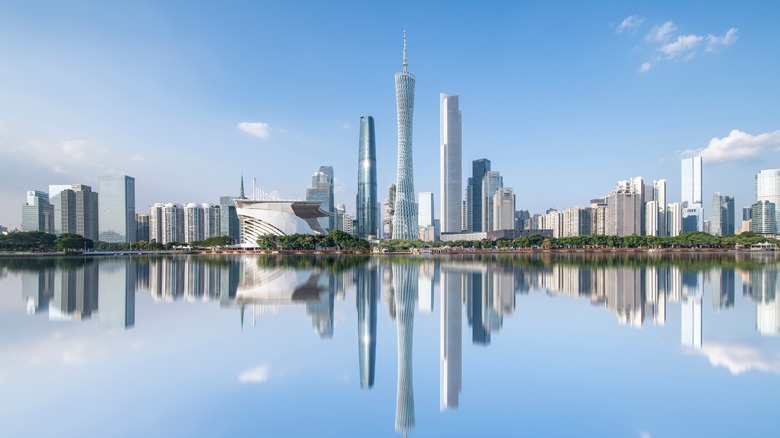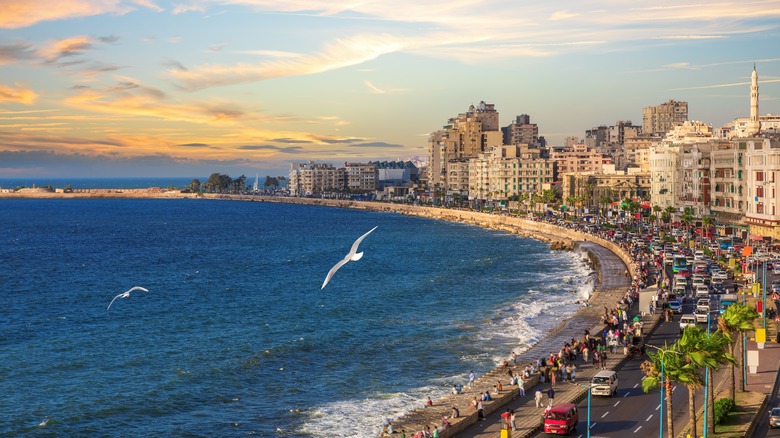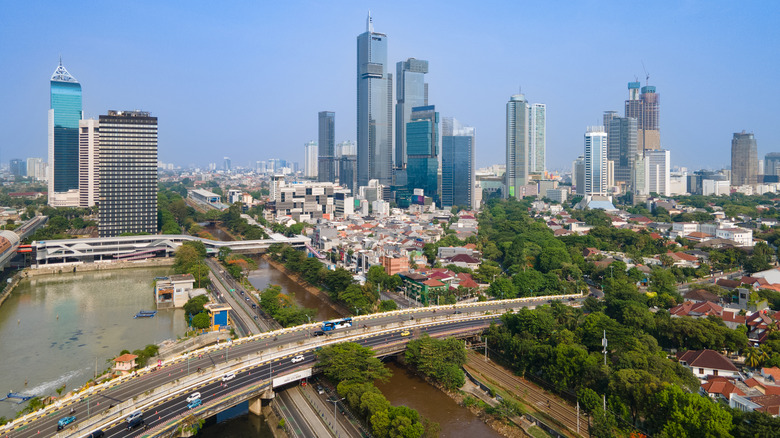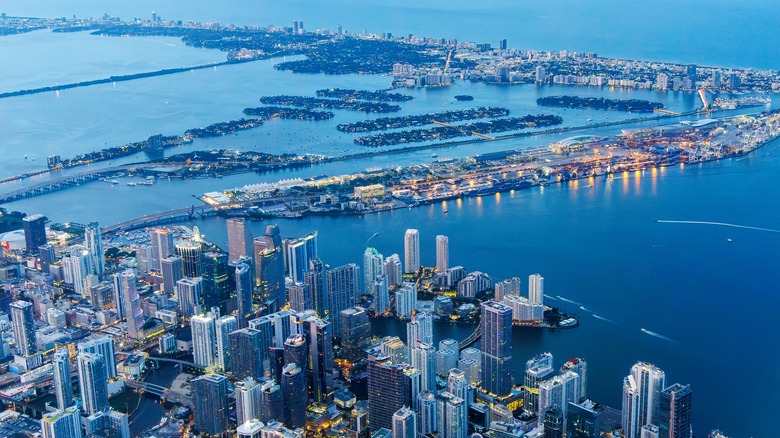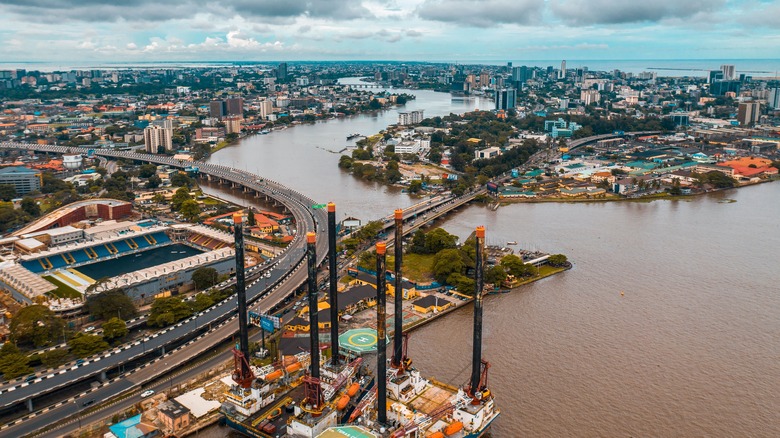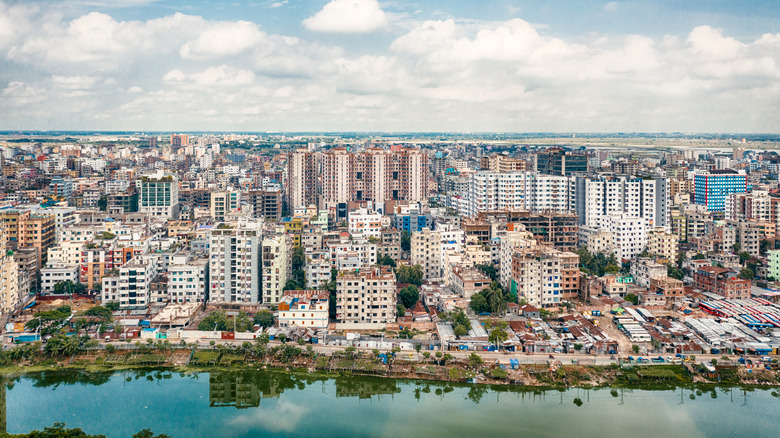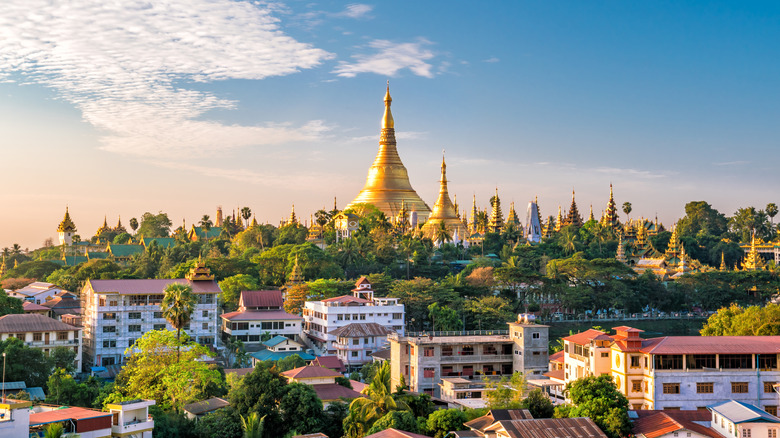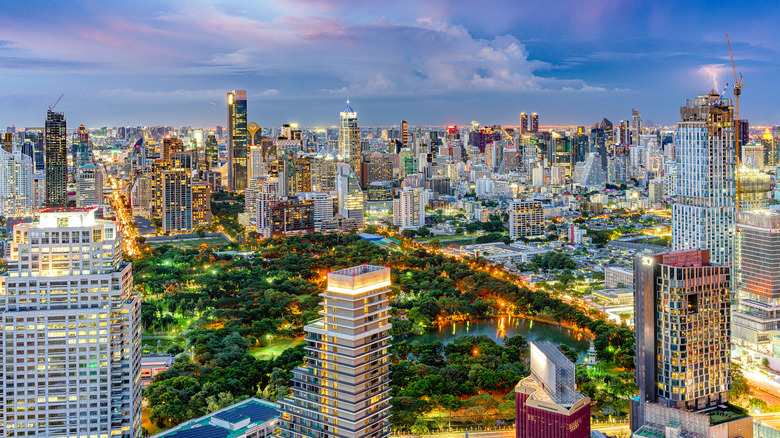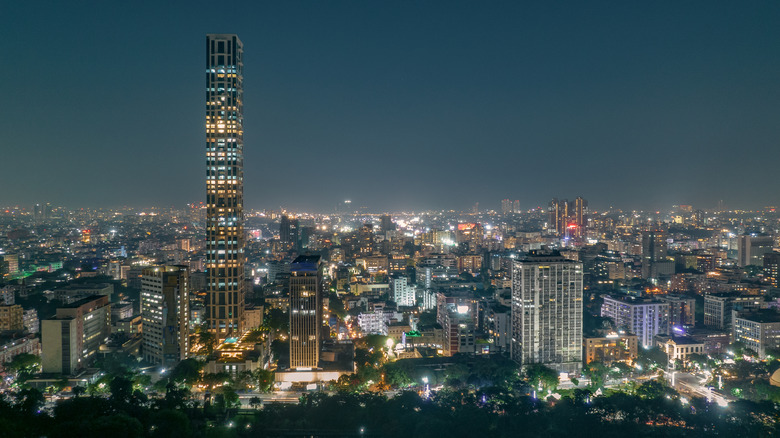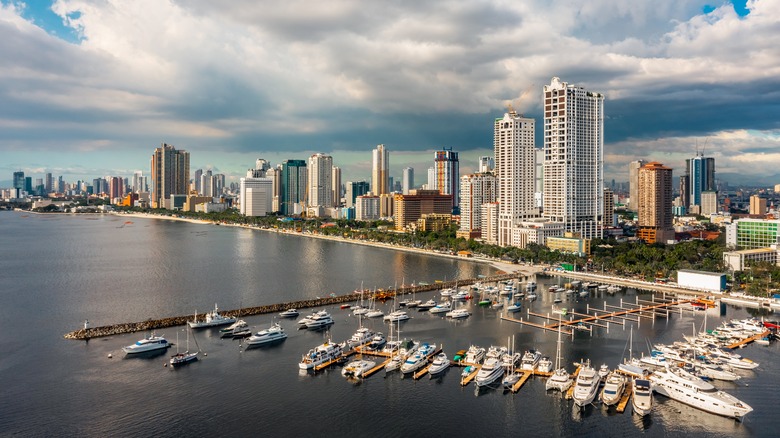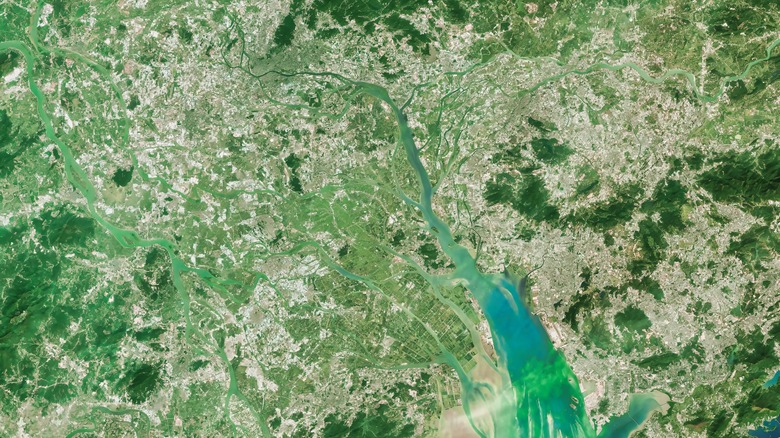10 Massive Cities That Are Actually Sinking Into The Ocean
Thanks to the escalating effects of climate change, some of the world's largest cities could meet the same fate as Atlantis by the end of this century. Rising sea levels are one of the worst environmental consequences of melting polar ice, and since most of humanity's major population centers are built on waterfronts, this poses one of the biggest imminent threats to our species. NASA estimates that sea levels could rise 3 to 6 feet by the year 2100, which would displace hundreds of millions of people.
Some of the world's most populated coastal areas are already in the process of being swallowed by the sea. Floods, which already affect more people than any other type of natural disaster, are becoming more frequent and severe, wreaking billions of dollars in damage that will only grow worse, as Earth is projected to warm 3.2 degrees Celsius by the end of the century. Here are 10 global cities facing submersion as we approach this grim future, including the most populous place on Earth.
1. Alexandria, Egypt
Alexandria is the second largest city in Egypt and the largest city on the Mediterranean Sea, with an estimated 2024 population of 5.7 million. The city's history is amongst the richest in the world, having been founded in the year 332 B.C. by none other than Alexander the Great, who also serves as its namesake. It emerged as one of the most significant points of economic and cultural exchange between Europe and the Middle East. It also gained a reputation as the world's foremost center for learning, thanks to the famed Library of Alexandria.
To this day, the port of Alexandria remains a critical hub for transcontinental trade, particularly shipments of oil. The city serves as one terminus of the SUMED Pipeline, an oil pipeline between the Red Sea and the Mediterranean used to ship crude oil and natural gas from the Arabian Peninsula to Europe. Unfortunately, the negative effects of using those fossil fuels have included melting glacial ice, and Alexandria is already seeing some of its beaches disappear. The UN climate panel has predicted that as much as 30% of the city could be underwater by 2050, displacing at least 1.5 million people. The flooding could also extend through much of the Nile Delta, destroying one of the cradles of civilization.
2. Jakarta, Indonesia
Jakarta is Indonesia's capital and largest city, with an estimated 2024 population of 11.4 million. Located on the north coast of the island of Java, it is an important economic hub for Southeast Asia, and its global prominence is steadily rising with Indonesia now ranked as the fourth most populous nation. Unfortunately, Jakarta is also known as one of the fastest-sinking cities in the world, and the issue has become so extreme that the Indonesian government has chosen to abandon it as a capital.
Jakarta is sinking at an alarming rate of 17 centimeters (6.7 inches) each year. The city lies on low features of a floodplain that was historically dominated by swampland, and there are 13 rivers running through the urban area out to the Java Sea, making the entire region extremely vulnerable to rising waters. Jakarta has experienced a growing number of floods since the turn of the century, most severely in 2007, when floodwaters claimed 80 lives in the city and dealt hundreds of millions of dollars in damage.
In 2022, the Indonesian government announced that it would abandon Jakarta and build a brand-new capital city from the ground up on the island of Borneo. Jakarta's flood risk was cited as a principal reason for the move, along with its congestion and pollution. The new capital, named Nusantara, is expected to be complete in 2045, at which point it may also become a haven for those escaping sunken Jakarta.
3. Miami, Florida
Miami boasts an estimated 2024 population of roughly 460,000, but it forms the base of a much larger megaregion. The Miami-Fort Lauderdale metropolitan area is the fourth largest urban area in the United States after New York, Los Angeles, and Chicago, with over 6 million residents living in its various municipalities. It serves as one of the country's major hubs for international trade, tourism, and immigration. All come by virtue of the city's ideal positioning on Florida's southern tip, which has earned it the reputation of "Gateway to Latin America" and "Gateway to the Caribbean". However, Miami's location also presents a dire issue in the face of climate change.
More than half of Miami-Dade County is less than 6 feet above sea level, and up to 60% of it could be underwater by 2060. The situation in Miami has been made all the more dire by the fact that the city is growing rapidly, particularly through luxury highrise developments directly on the waterfront. Miami has over $400 billion worth of real estate exposed to flood risk, more than any other city in the world, and that number is only going up. In a worst-case climate scenario, which unfortunately appears to be ever more likely, the sinking of Miami could result in one of the worst natural disasters in history by economic damage.
4. Lagos, Nigeria
Lagos is the largest city in Africa, with a 2024 population of 16.5 million. That number is slated to rise steeply in the coming years, with Lagos being one of the fastest growing major cities in the world. As Nigeria has experienced rapid industrialization over the past 50 years, there has been a massive population shift from the country's rural regions to its capital city. Around 2,000 Nigerians move to Lagos every day as the country continues this dramatic change. This sharp rise in population has opened new economic doors for many, but it has also put millions at risk of rising waters.
Lagos regularly experiences heavy flooding in the summer, the economic consequences of which costs the city billions of dollars per year. Lagos is in an inherently problematic position, being located on a low plain, with the historic heart of the city on an island. The land is now sinking at a rate of more than 3 inches per year, and Lagos' notoriously inefficient drainage systems are already being pushed beyond their capabilities. The city has tried to make the best of the advantages (and disadvantages) of flood defenses in the form of a massive concrete barrier wall dubbed, "The Great Wall of Lagos." However, this project itself has been blamed by some for exacerbating Lagos's flood risk. The concrete used in the countless, similarconstruction projects fueling the city's growth, comes from sand mined along the coast. Nigeria's coastline has been heavily eroded by sand mining, pitting the nation's rapid urbanization against its long-term future.
5. Dhaka, Bangladesh
Dhaka, the capital of Bangladesh, is the fourth most populous city in the world, with an estimated population of 23.9 million in 2024. It lies on a shallow plain in the Ganges River, the largest river delta in the world, where multiple waterways empty into the Bay of Bengal. The months of June through September constitute the monsoon season, during which time floods break out throughout much of the country.
The United Nations has ranked Bangladesh amongst the top 10 countries most affected by natural disasters due to the frequency and scope of its floods. As climate change has exacerbated monsoons, floods have grown worse, wiping out communities along the country's coastlines. Bangladeshis displaced from rural areas by floods have poured into Dhaka, causing the city's population to climb ever higher. Unfortunately, the city they are moving to will offer little protection from rising sea levels in the long run.
Dhaka faces the threat of submersion for multiple reasons. For starters, its location in a river delta feeding a bay places the city very near sea level and virtually surrounded by water. On top of that, the city has been aggressively pumping groundwater from beneath the land to supply its growing population. This has resulted in portions of Dhaka sinking as much as half an inch per year, which comes on top of the projected rise in sea levels around the globe.
6. Yangon, Myanmar
Myanmar and its capital city of Yangon are still known to many westerners by their colonial names of Burma and Rangoon, despite the fact that both names were officially changed back in 1989. Formerly the national capital, and still the largest city in Myanmar, Yangon boasts an estimated 2024 population of 5.7 million. The historical city is famed for its mix of native and colonial influences, and is also an important center for Buddhism, holding some of the world's oldest and grandest pagodas. The golden Shwedagon Pagoda draws as many as 50,000 pilgrims in a day, most from within Myanmar, but others from all around the world.
Yangon sits in a river delta, with much of the city built upon silt and clay river deposits. Bordering the Gulf of Martaban, the city experiences summer monsoons, which bring surging tides and river levels to an already low-lying region. Consequently, Yangon already suffers from frequent flooding. The city's infrastructure has also proven ill-equipped to handle the growing threat of climate change, with the free gravity-based drainage systems frequently backing up due to swells from the tides and rivers. Excessive groundwater extraction is also exacerbating the issue. Yangon lies just a few kilometers away from the Sagaing Fault, and if a major earthquake were to hit the region, it could cause groundwater wells to collapse and sink massive portions of the city.
7. Bangkok, Thailand
Bangkok is Thailand's capital and only major city, with an estimated 2024 population of 11.2 million. As with other cities on this list, Bangkok's location, though historically advantageous for trade and defense, has become a major issue in light of rising sea levels. The city lies in a delta plain where the Chao Phraya River empties into the Gulf of Thailand, putting it at low elevation and surrounded by water. Bangkok's vast network of canals have even earned it the nickname "Venice of the East". To complicate matters further, Bangkok is very densely developed, partly because the historic city center used to be bound by a wall. Since the 1960s, the city has been expanding at an aggressive pace, expanding as far as the water will allow.
Bangkok is swiftly losing ground to the rising sea, and the coastline will creep inwards by over a kilometer each year. In a century, most of the city will likely be submerged. Already, neighborhoods along the waterfront are being swallowed up, driving residents closer to the city center. Whole fishing villages that once constituted the outer reaches of the Bangkok metro area no longer exist. In the face of rising waters, some residents have rebuilt their homes on tall stilts, hoping to simply outpace the sea. It's a grim situation for Bangkok, but it could be even worse, had the city not banned groundwater pumping after huge amounts of land were lost in the 1970s.
8. Kolkata, India
Kolkata is the third largest city in India, with an estimated 2024 population of 15.6 million. It formerly served as the capital of British-controlled India under the name Calcutta, by which it is still widely known. The economic and cultural center of eastern India, Kolkata's location is ideal for things like international trade, but those traits are the opposite of an advantage in the face of climate change. Kolkata is situated near the border between India and Bangladesh, and it lies in the lowlands of the Ganges Delta, upstream from the Bay of Bengal.
In addition to the threat of rising waters, Kolkata is sinking due to excessive groundwater extraction. The city is primarily built upon silt deposits from the river delta, and parts of it are already below sea level. Flooding is a common issue, particularly when tropical cyclones hit. As with hurricanes in the Americas, cyclones in South Asia have been growing more frequent and destructive with the advancement of climate change. In 2024, floods in West Bengal, the state that Kolkata serves as capital of, affected over 250,000 people. If mass flooding of such a nature were to hit the core of the city itself, it could displace more than 10 million people.
9. Manila, Philippines
Manila is the capital of the Philippines, and along with 15 other cities, most notably Quezon City, it forms the massive Metropo Manila region, which in 2024 had an estimated population of 14.9 million. Manila also has the highest population density of any city in the world, with over 110,000 people per square mile. Here, we once again find a city where geography and human industry have collided in disastrous fashion. Manila is built on a low-lying swampy plain where the Pasig River flows into Manila Bay. Historically, it was an ideal location for a harbor, but the land is now being threatened by the familiar forces of rising sea levels and groundwater pumping.
The combined forces of groundwater extraction paired with seismic activity from the active Taal volcano a mere 31 miles from the city have made the ground Manila stands on highly unstable. Portions of the city are sinking as fast as 4 inches per year, far outpacing the global rate of sea level rise. Another issue particular to Manila is the destruction of mangrove forests along the coast of Manila Bay. These trees had historically served as a natural barrier against erosion, but since the turn of the 20th century, over 130,000 acres of mangroves forest along Manila Bay have been cut down. A large seawall has since been built in Manila Bay, but with the rapid expansion of the city, there are still neighborhoods left exposed outside its reaches.
10. Guangdong-Hong Kong-Macao megalopolis
The Guangdong-Hong Kong-Macao Greater Bay Area is the largest and most populated urban area in the entire world, with an estimated population of about 86.9 million people. It comprises 11 interconnected cities, including the special administrative regions of Hong Kong and Macao along with nine cities in the Chinese province of Guangdong, the largest being Guangzhou. The entire urban mass is concentrated around the Pearl River Delta near the South China Sea. The region is low, swampy, and marked with numerous canals, all conditions which present major concerns in the face of rising sea levels.
As much as a quarter of China's current coastline could be underwater by the next century, threatening many of its major cities, including those in the Greater Bay Area. The Pearl River Delta could see more than 5 feet of water rise over the next hundred years. The severity of the issue varies somewhat between the region's municipalities. Neither Macao nor Hong Kong pump groundwater, but subsidence is a major issue for Guangzhou and other Chinese cities. All told, the Greater Bay Area is one of the most economically consequential regions on the planet. In 2021, the GDP of this urban area alone was $2 trillion, equal to the entirety of Canada. A third of Chinese exports come from the Pearl River Delta megalopolis, and all of those goods we rely on, not to mention the millions of people involved in producing them, are all in danger of sinking.
